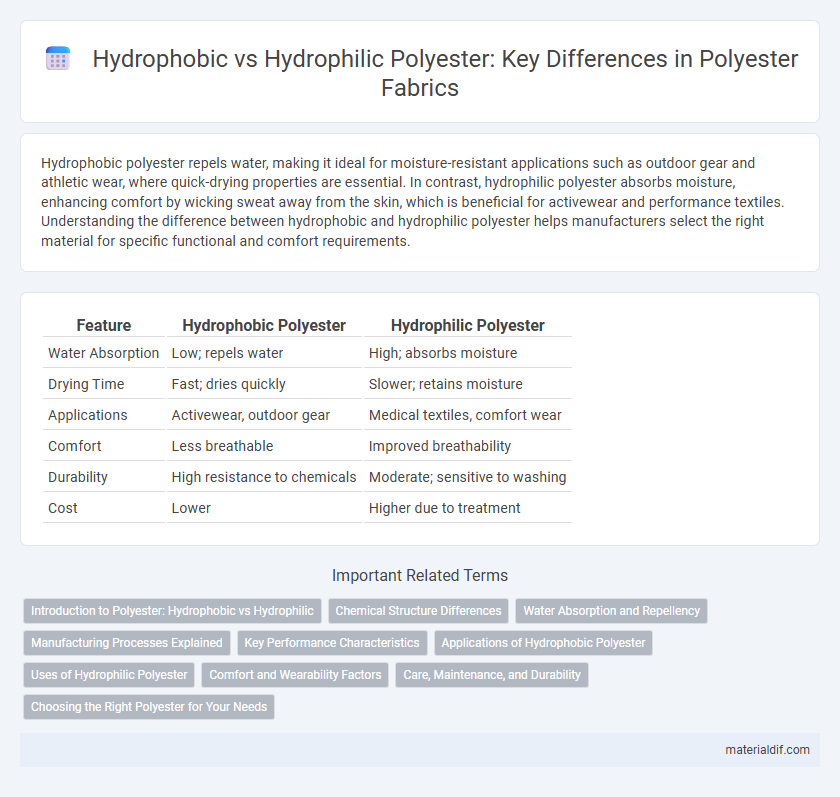Hydrophobic polyester repels water, making it ideal for moisture-resistant applications such as outdoor gear and athletic wear, where quick-drying properties are essential. In contrast, hydrophilic polyester absorbs moisture, enhancing comfort by wicking sweat away from the skin, which is beneficial for activewear and performance textiles. Understanding the difference between hydrophobic and hydrophilic polyester helps manufacturers select the right material for specific functional and comfort requirements.
Table of Comparison
| Feature | Hydrophobic Polyester | Hydrophilic Polyester |
|---|---|---|
| Water Absorption | Low; repels water | High; absorbs moisture |
| Drying Time | Fast; dries quickly | Slower; retains moisture |
| Applications | Activewear, outdoor gear | Medical textiles, comfort wear |
| Comfort | Less breathable | Improved breathability |
| Durability | High resistance to chemicals | Moderate; sensitive to washing |
| Cost | Lower | Higher due to treatment |
Introduction to Polyester: Hydrophobic vs Hydrophilic
Polyester, a synthetic polymer widely used in textiles, exists in hydrophobic and hydrophilic forms distinguished by their water interaction properties. Hydrophobic polyester repels water, making it ideal for moisture-resistant applications, while hydrophilic polyester absorbs water, enhancing comfort in moisture-wicking fabrics. Understanding these differences is crucial for selecting materials in performance apparel, medical textiles, and industrial uses.
Chemical Structure Differences
Hydrophobic polyester is characterized by non-polar chemical structures, predominantly composed of terephthalate units that repel water molecules due to their lack of polar functional groups. In contrast, hydrophilic polyester incorporates polar groups such as hydroxyl or carboxyl functional units within its polymer chains, enhancing water absorption and affinity. These chemical structure differences significantly influence the material's moisture management properties and applications in textiles and industrial uses.
Water Absorption and Repellency
Hydrophobic polyester exhibits low water absorption, typically less than 0.05% moisture regain, making it highly water-repellent and ideal for moisture-wicking applications. In contrast, hydrophilic polyester fibers are chemically modified or blended to increase water absorption up to 3-4%, enhancing comfort by allowing better moisture management and breathability. Water repellency in hydrophobic polyester results from its non-polar molecular structure, whereas hydrophilic polyester incorporates polar groups that attract and retain water molecules.
Manufacturing Processes Explained
Hydrophobic polyester is produced through melt spinning, where polymer chips are melted and extruded to form fibers with low moisture absorption properties, enhancing water resistance. Hydrophilic polyester, however, undergoes surface treatment or copolymerization during manufacturing to introduce hydrophilic groups, improving moisture management and fabric comfort. Both processes involve precise control of temperature, extrusion speed, and chemical additives to achieve the desired fiber characteristics for specific applications.
Key Performance Characteristics
Hydrophobic polyester resists water absorption, enhancing moisture-wicking and drying speed, making it ideal for activewear and outdoor applications. Hydrophilic polyester absorbs moisture, improving comfort and breathability by allowing better sweat management in everyday clothing. Key performance characteristics include water repellency for hydrophobic fibers versus enhanced moisture retention and softness for hydrophilic variants.
Applications of Hydrophobic Polyester
Hydrophobic polyester is widely used in outdoor apparel and sportswear due to its excellent water-repellent properties, which enhance moisture resistance and durability. This type of polyester is ideal for performance fabrics requiring quick-drying capabilities and protection against rain, making it suitable for jackets, tents, and backpacks. Industries such as automotive and upholstery also favor hydrophobic polyester for its resistance to stains and ease of cleaning.
Uses of Hydrophilic Polyester
Hydrophilic polyester is widely used in medical textiles, sportswear, and filtration systems due to its excellent moisture absorption and breathability. Unlike hydrophobic polyester, which repels water and is ideal for outdoor and waterproof applications, hydrophilic variants enhance comfort by efficiently wicking sweat away from the skin. Its ability to absorb and retain water makes hydrophilic polyester crucial in wound dressings and hygiene products, promoting faster healing and better hygiene.
Comfort and Wearability Factors
Hydrophobic polyester fibers repel moisture, enhancing quick-drying properties and reducing sweat absorption, which improves comfort during high-intensity activities. Hydrophilic polyester, treated to attract and retain moisture, offers better breathability and a softer feel, making it suitable for everyday wear and sensitive skin. The choice between hydrophobic and hydrophilic polyester directly influences wearability, balancing moisture management and tactile comfort for different lifestyle needs.
Care, Maintenance, and Durability
Hydrophobic polyester repels water, making it ideal for outdoor gear as it resists stains and dries quickly, thus requiring minimal maintenance. Hydrophilic polyester absorbs moisture, which can lead to slower drying times and potential odor buildup if not properly cared for. Durability in hydrophobic polyester is generally higher in wet conditions due to its water-resistant properties, while hydrophilic polyester may require more frequent washing to maintain freshness and prevent fiber degradation.
Choosing the Right Polyester for Your Needs
Hydrophobic polyester repels water and offers excellent moisture resistance, making it ideal for outdoor apparel, sportswear, and water-resistant fabrics. Hydrophilic polyester absorbs moisture, enhancing comfort and breathability, which is perfect for activewear and moisture-wicking garments. Choosing the right polyester depends on the intended use, whether prioritizing water resistance or moisture management for optimal performance and comfort.
Hydrophobic Polyester vs Hydrophilic Polyester Infographic

 materialdif.com
materialdif.com